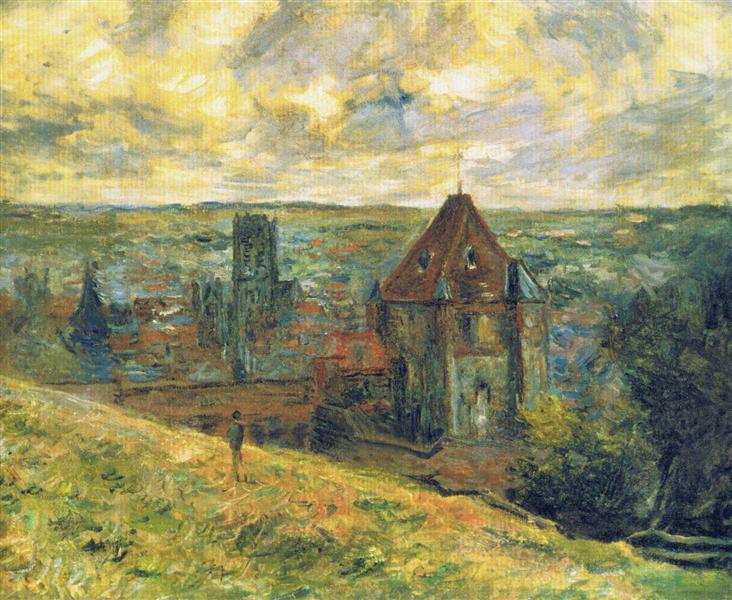Description
Claude Monet's "Dieppe - 1882" masterfully captures the essence of the seascape, a recurring theme in the Impressionist painter's work. In this painting, Monet immerses himself in the coastal landscape of Dieppe, a port town in Normandy, reflecting not only his technical skill, but also his fascination with light and atmosphere.
From the first glance, the painting appears vibrant and dynamic, with a bold use of the colour palette. Monet uses blue and green tones to depict the sea, contrasting with the soft grey and brown tones of the buildings and sand in the surroundings. This juxtaposition of colours creates a sense of depth and movement, characteristic of the Impressionist style. Light plays a fundamental role in this work, where Monet captures the changing atmosphere and the reflection of light on the surface of the water. The loose, almost abstract brushstrokes that the artist uses suggest the ebb and flow of waves and the gentle movement of air.
The composition is arranged in such a way as to invite the viewer to follow the line of the horizon, where the sky meets the sea. The sky, rendered with clouds of grey and lavender tones, suggests a cool and possibly windy day, a feeling accentuated by the fluid shapes that the clouds take. Monet manages to balance the sky with the land and the sea in such a way that each element is articulated in a visual dialogue, creating a sense of harmony and continuity.
At the bottom of the composition, Monet includes human figures and boats, small in proportion to the vast landscape that surrounds them. These figures, though blurred and diffuse, are representative of everyday life and the interaction of humans with the natural environment, a recurring theme in Monet's art. The inclusion of the boats, almost as silhouettes, bears witness to the fishing and commercial activity that characterizes Dieppe. This notion of life and movement adds a level of narrative that invites the viewer to imagine the stories framed by this landscape.
It is interesting to note that "Dieppe - 1882" is set in a crucial period of Monet's career, where his style became increasingly free and experimental. Monet increasingly explored the possibilities of light and colour, moving away from the academic conventions that had dominated art until then. The work is part of the context of Impressionism, a movement that began as a rebellion against naturalistic representation and sought to capture the visual experience and the immediacy of perception.
This oil on canvas is presented not only as a visual record, but also as a sensory experience. Through his characteristic effects of light and shadow, Monet transports us to the Dieppe coast, allowing us to feel the sea breeze and hear the murmur of the waves. As the viewer immerses himself in the work, it becomes clear that Monet did not just paint what he saw, but what he felt when faced with nature, turning his art into an emotional interpretation of the beauty of the world.
In conclusion, "Dieppe - 1882" is not only an example of Monet's exceptional talent, but also a manifestation of the Impressionist quest for visual and emotional truth. His ability to capture the landscape in such sensorial detail and his skill in manipulating color and light make this work a fascinating piece that will continue to resonate with the lover of art and natural splendor.
KUADROS ©, a famous painting on your wall.
Hand-made oil painting reproductions, with the quality of professional artists and the distinctive seal of KUADROS ©.
Painting reproduction service with satisfaction guarantee. If you are not completely satisfied with the replica of your painting, we will refund 100% of your money.

